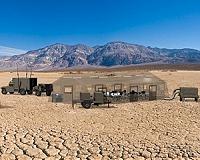| . |  |
. |
McLean VA (SPX) Feb 24, 2011 The U.S. Army has approved for fielding the next-generation Force XXI Battle Command Brigade and Below (FBCB2) system, called Joint Capabilities Release (JCR). FBCB2 JCR, developed by Northrop Grumman Corporation will give warfighters significantly enhanced capabilities for battle command. FBCB2 is the key situational awareness and command-and-control system used by U.S. and coalition forces. More than 95,000 FBCB2 systems have been deployed worldwide, forming the world's largest tactical network. The system has been successfully fielded for 16 years. JCR will be incorporated into the LandWarNet/Battle Command Baseline for fielding to deploying units scheduled to receive software block 2. JCR upgrades include an increase in network bandwidth that allows the system to move more information to more users within seconds rather than in minutes. JCR also provides a common FBCB2 platform solution for both the Army and U.S. Marine Corps. "The ability to receive and share battlefield data through a broad-based, reliable network is increasingly important and critical to the mission. JCR provides new collaboration tools and other enhancements that are orders of magnitude more capable than what is available to soldiers and Marines today," said Joe G. Taylor, Jr., vice president of the Ground Combat Systems business unit within Northrop Grumman's Information Systems sector. The system includes Blue Force Tracking 2 (BFT 2), a high-tech, high-speed force-tracking satellite-communications network. The Army says BFT 2 will be roughly 10 times faster than the existing BFT system. When JCR is fielded with the new BFT 2 transceiver and network upgrade, friendly positions will be updated in seconds. With JCR, warfighters will also be able to share more broadly critical, sensitive information. The BFT 2 will include a new Programmable In-Line Encryption Device that is fully compatible with JCR. Other new JCR capabilities include the Commercial Joint Mapping Tool Kit and an over-the-air self-descriptive situational awareness (SDSA) capability. SDSA will eliminate inflexible fixed databases and allow FBCB2-equipped units to change task organizations in the field to meet new mission requirements. JCR represents a major departure from the original FBCB2 architecture. The new JCR approach is called the "Battle Command Product Line" (BCPL) and is designed to correct the "stovepipe" development approach taken by earlier command and control systems. Properly executed, BCPL will enable the Army to develop, test, certify and deploy software capabilities more quickly and at a lower cost. The version that will be fielded is JCR-Vehicle L-Band (v) 1.1.1.4 V-4. The Army and Marine Corps are currently testing JCR V1.3.1 and considering it for a fielding upgrade this year. FBCB2 links communication devices, sensors, vehicles, rotary-wing aircraft and weapons platforms in a seamless digital network to provide a clear, continuous and common picture of the battlefield. Most FBCB2 systems communicate via a satellite-based network; about 30 percent use the Enhanced Position Location Reporting System, or EPLRS, tactical radio network. Northrop Grumman Corporation was awarded the first FBCB2 development contract in January 1995.
Share This Article With Planet Earth
Related Links - Read the latest in Military Space Communications Technology at SpaceWar.com
 Boeing To Demonstrate Aviation Command And Control Subsystem For US Marine Corps
Boeing To Demonstrate Aviation Command And Control Subsystem For US Marine CorpsSt. Louis MO (SPX) Feb 24, 2011 Boeing has received a nearly $5 million demonstration contract for the U.S. Marine Corps Common Aviation Command and Control System (CAC2S) program. CAC2S will upgrade the service's Marine Air Command and Control System. The contract award supports development of a sensor data subsystem to integrate input from various Marine Corps sensors. The company will present its system to the M ... read more |
|
| The content herein, unless otherwise known to be public domain, are Copyright 1995-2010 - SpaceDaily. AFP and UPI Wire Stories are copyright Agence France-Presse and United Press International. ESA Portal Reports are copyright European Space Agency. All NASA sourced material is public domain. Additional copyrights may apply in whole or part to other bona fide parties. Advertising does not imply endorsement,agreement or approval of any opinions, statements or information provided by SpaceDaily on any Web page published or hosted by SpaceDaily. Privacy Statement |